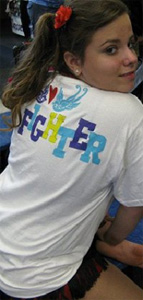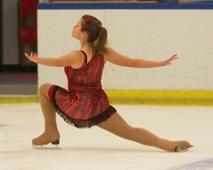



This doesn’t look good,”my neurosurgeon,Dr. Fletcher warned. “Madalyn has Hydrocephalus.” That same day, at just 5 ½ weeks, Dr.Fletcher took me out of my mother’s arms and carried me down to the operating room for a VP shunt placement- my first brain surgery. Recently after I was diagnosed, mom called a support group to get more information. The voice on the other end told her that 75% of kids with Hydrocephalus don’t usually walk until they are 3 and some might not even walk as well as other horrible things. I can’t even imagine how my mom must have felt.
Throughout my early childhood, Hydrocephalus already began to affect my life. At 4 years old; a shunt malfunction interrupted the day’s plans. Mom panicked as she drove me to the ER while I continuously vomited in the back seat.
By the time I was 5, Mom started taking me to physical therapy to ensure I was intellectually developing correctly. Throughout elementary, Resource (special Ed) offered the help I needed for my struggles in math and still allowed me to be in the “normal” classroom. With certain limitations, P.E became a challenge. Quite often, I took shelter in the equipment room and watched all the other kids playing with soccer balls. I knew that I couldn’t break the “golden rule” of NO CONTACT SPORTS. As I sat out, I knew I was different but didn’t understand the details. When I was able to participate, I was in constant fear of flying basketballs and volleyballs hitting my shunt. Other than PE limitations and learning challenges, headaches often made my elementary life difficult. Many visits to the nurse for headaches and migraines seemed to be the norm. In 2nd grade, I underwent ICP monitoring in the PICU at Texas Children’s Hospital for catheter concerns.
After a rough 6th grade year and another shunt revision, I left public school and attended LSA for the start of 7th grade. By then, I finally broke out of my shell and would never expect what I would soon discover. That April, I began taking figure skating lessons. Dangerous falls did come to mind, but my balance and well- being improved. As high school rolled around, I continued skating and became more involved by participating in the annual skating shows. After struggling in math once again, I left LSA once I was accepted to Clear View, a school with smaller classes and more help. Clear View seemed to be the place for me.
Sophomore year- the smaller classes and help available really made math a lot easier. During November, just as I began to get used to the new school, struggles with my Hydrocephalus returned. My catheter began to painfully grind against my collar bone, which made everyday tasks and figure skating difficult, so I visited my neurosurgeon. After unsuccessful attempts of pain pills and injected steroids along my catheter track, surgery was the only other option. He ordered an MRI to see if I would be a candidate for the ETV procedure. If I was, I would be SHUNT FREE!! My results came back and turns out I was a candidate. It seemed a dream come true to become shunt free!
Not much later, we receive a phone call from my neurosurgeon requesting to meet with my mom. (I wasn’t allowed to go) The day Mom was meeting with Dr.Fletcher, I went skating with my coach in hopes to keep my mind off of it. In the early afternoon, Mom answers her phone with the news “Dr. Fletcher said that you are no longer a candidate for the ETV procedure. The radiologists found a brain tumor. He thinks it’s a mid brain glioma, but is sending you to a doctor at MD Anderson just to make sure.” I froze. A brain tumor? A cancer hospital?! My hopes of becoming shunt free just shattered.
July 13, 2009, I had another revision and Dr. Fletcher removes as much calcified catheter as he can. A neck, abdominal, and head incision, as long as my head, I made recovery difficult and painful. The next month, I met my doctor at MD Anderson. He confirmed that Dr.Fletcher’s finding was a mid brain glioma. Fortunately, it is a benign and a grade 1 (meaning it will grow very slowly if at all). Throughout my sophomore, I underwent monthly checkups for my tumor. Once my tumor didn’t seem to show any growth after continual checkups, my doctors lessened my checkups to every 3 months and by senior year, only once a year. A few months after turning 17 and getting a new skating coach, I became a competitive figure skater.
 The “Yellow Epidemic”
The “Yellow Epidemic”September – National Hydrocephalus Awareness Month: When my teacher, who I call "Momma D", realizes the reason for all of my yellow, she takes action. Before I left for class, she walks out into the hallway to a small cluster of students."Wear yellow this month for National Hydrocephalus Awareness Month", she said still with her arm around me. Of course I got nervous. That day Momma D told all of her classes to wear yellow as much as possible in September, explained why and what Hydrocephalus was .Surprisingly, students were asking questions about Hydrocephalus. The next day Momma D was handing out yellow ribbons to wear. “You inspired me to do this. We are going to make a difference,” she told me after thanking her countless times. Throughout the month, Momma D had me write announcements that gave a couple of facts about Hydrocephalus.
My friends became quite involved. Theresa presented me with a handmade shirt signed by friends and teachers in front of the entire school and principal. Shelbie also made me a shirt that read “Team Find A Cure” on the front and “Fighter” on the back. Later in the month, Momma D said “There is 50 yards of yellow ribbon walking around the school.” Speechless and overwhelmed, I now know that I have a school full of support. September, no longer just a month anymore, but a month dedicated for Hydrocephalus awareness.
 As I continue my senior year of high school, I have realized that speaking out for an important cause is 100% beneficial in the long run. The right people will listen and be there for support. Although I am still battling against Hydrocephalus, life is an even bigger privilege.
As I continue my senior year of high school, I have realized that speaking out for an important cause is 100% beneficial in the long run. The right people will listen and be there for support. Although I am still battling against Hydrocephalus, life is an even bigger privilege.



